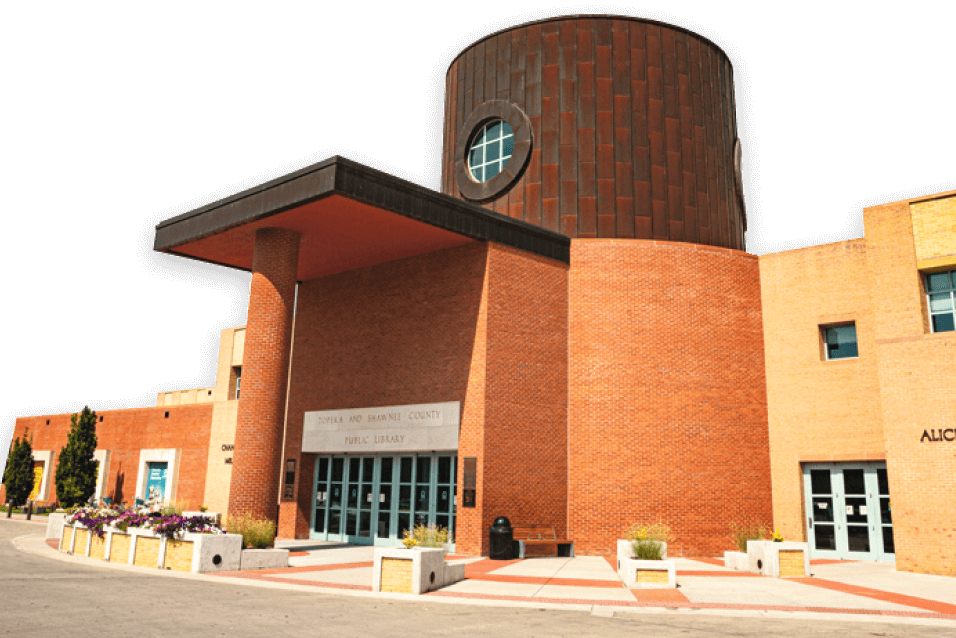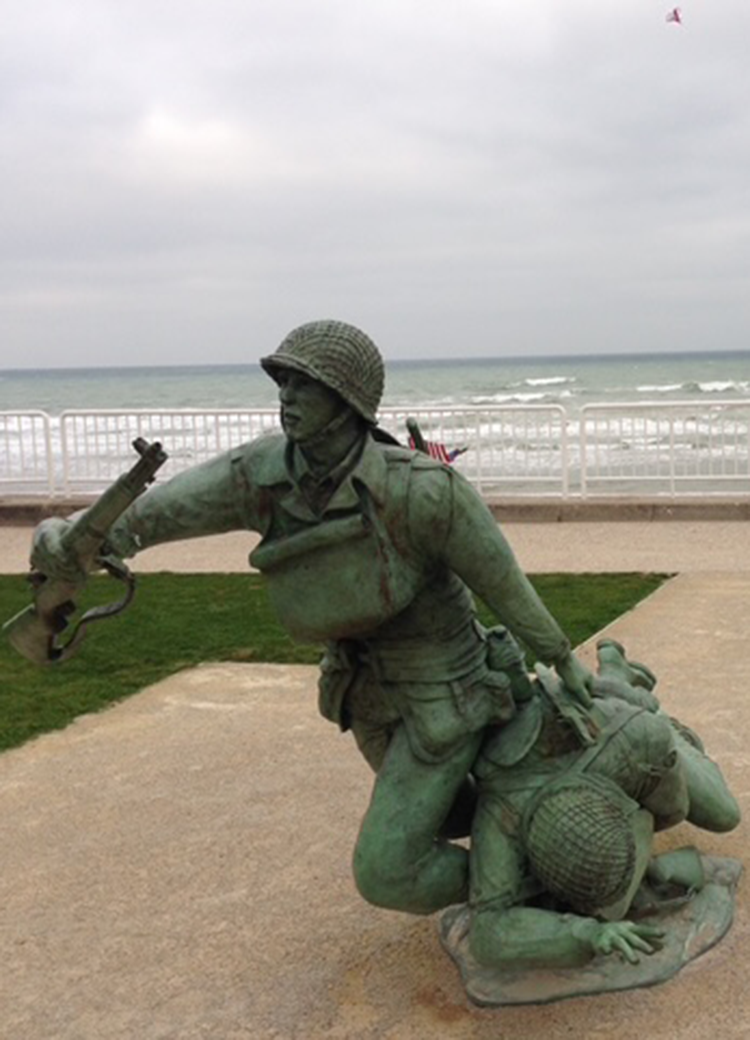Shawnee County Stories of D-Day
Shawnee County Stories of D-Day
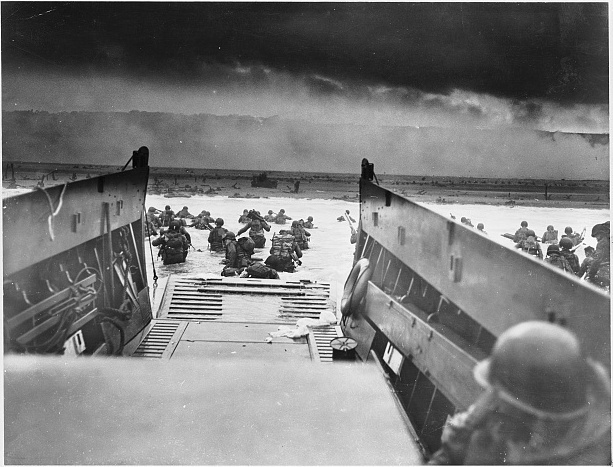 This famous image - titled "Taxis to Hell - and Back" - shows the open and hazardous terrain faced by the men who stormed Omaha Beach (Photo courtesy of the Library of Congress)
This famous image - titled "Taxis to Hell - and Back" - shows the open and hazardous terrain faced by the men who stormed Omaha Beach (Photo courtesy of the Library of Congress)On the morning of June 6, 1944, an estimated 73,000 American troops landed on the beaches of Normandy, France, in what would come to be known as D-Day. They joined 13,4000 paratroopers who had landed behind enemy lines. The American forces, combined with those from the other Allied countries, successfully carried out the largest land, sea and air invasion in military history, and were able to liberate France from the occupying German forces.
In among the forces that landed the five beach heads – Omaha, Utah, Gold, Juno and Sword – or parachuted into the French countryside, were many American soldiers from Kansas. The five individuals whose stories are told below are a sampling of those with Shawnee County connections who took part in the D-Day invasion.
Donald Deam (1919-2008)
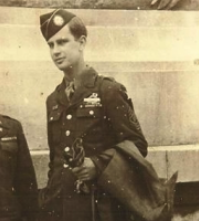 Donald Deam in uniform, circa 1943 (Photo courtesy of the Eisenhower Foundation)
Donald Deam in uniform, circa 1943 (Photo courtesy of the Eisenhower Foundation)Donald Deam was a member of the 501st Parachute Infantry Regiment of the 101st Airborne. The task given to the 101st was to land behind the German lines under the cover of night on June 5, 1944, and disrupt and distract the German forces before the main landings on the beaches.
Deam, born in Wichita on Sept 16, 1919, joined the army after the Japanese attacked Pearl Harbor in 1941. He was eventually sent to England to train with other parachutists for the Normandy invasion. They did practice jumps and were required to memorize landmarks so they could orient themselves after they landed.
But Deam later recalled, when they landed nothing looked familiar. He also found himself in immediate danger when he mistakenly landed in a 6-foot-deep canal and sank straight to the bottom. Deam quickly cut himself out of his chute and managed to get to the surface without becoming entangled in the lines from the parachute.
When Deam managed to find the rest of his group, he discovered he was the senior enlisted man and was therefore in charge of 200 men. The group came under enemy fire while trying to cross a stream. Despite being shot three times, Deam kept a cool head and supervised getting almost all 200 men across to meet up with the rest of the regiment. For his bravery and dedication Deam was awarded a Silver Star as well as a Purple Heart.
After the war Deam came back to Kansas and graduated from Washburn Law School. He practiced law in Topeka for 35 years until he retired in 1985. Before his death in 2008, Deam told the Topeka Capital Journal, “D-Day is something I will never forget. I live with it every day and night. I live with the rows of white crosses we left over there, too.”
James "Ed" Allison (1914-1944)
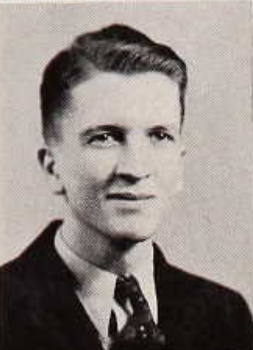 James "Ed" Allison's senior picture. He graduated from Topeka High School in 1933. (TSCPL)
James "Ed" Allison's senior picture. He graduated from Topeka High School in 1933. (TSCPL)The June 6, 1944, landing by Allied forces was only the start of the Normandy Invasion (codename “Operation Overlord”). During the nearly two-months long fight into France an estimated 29,000 American men lost their lives. One of those men was James Allison.
Allison had grown up in Topeka, graduated from Topeka High School in 1933 and attended Washburn University. He had managed several of the movie theaters in Topeka, including the Jayhawk and the Gem, before mustering into the Navy in 1943. After training at Princeton University, Camp Bradford and Fort Pierce, Allison was promoted to Lieutenant (j.g.) and assigned to the 5th Engineer Special Brigade. He was sent overseas in January 1944 in preparation for the Normandy invasion.
On June 7, 1944, Lt. Allison was on one of the many landing boats that were still coming ashore in France. The 5th Engineer Special Brigade’s task was to clear the beachheads of obstacles so the infantrymen and tank battalions behind them could land with issue. Allison had been given the position of beach master, which meant he would lead his men off the boat. This was an extremely dangerous position and, soon after landing, Lt. Allison was killed in action.
His body was originally buried with other American servicemen killed during the Normandy invasion at St. Laurent-sur-Mer in France. In 1947 Lt. Allison’s body was sent home to Topeka where it was reinterred on December 10 at Mount Hope Cemetery with full military honors.
Dudley P. May (1916-1961)
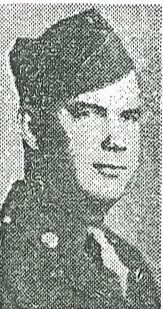 Sergeant Dudley May was a natural tinkerer and used his skills to help save many lives during the Normandy invasion (Photo courtesy of the Topeka Daily Capital)
Sergeant Dudley May was a natural tinkerer and used his skills to help save many lives during the Normandy invasion (Photo courtesy of the Topeka Daily Capital)There were many potential hazards infantry men and tank battalions had to contend with even after they got off the Normandy beaches. One that had been identified through photographs taken from reconnaissance planes were miles of hedgerows covering the French countryside.
These hedgerows had been around for hundreds of years and could be between three and 12 feet high and up to four feet thick. At their base, the earth had banked up over the years to create large mounds. These hedgerows presented a problem for the advancing Allied forces, especially the tanks. While tanks were able to go over mounds of earth, it would tip the tank upwards exposing the unprotected undersides.
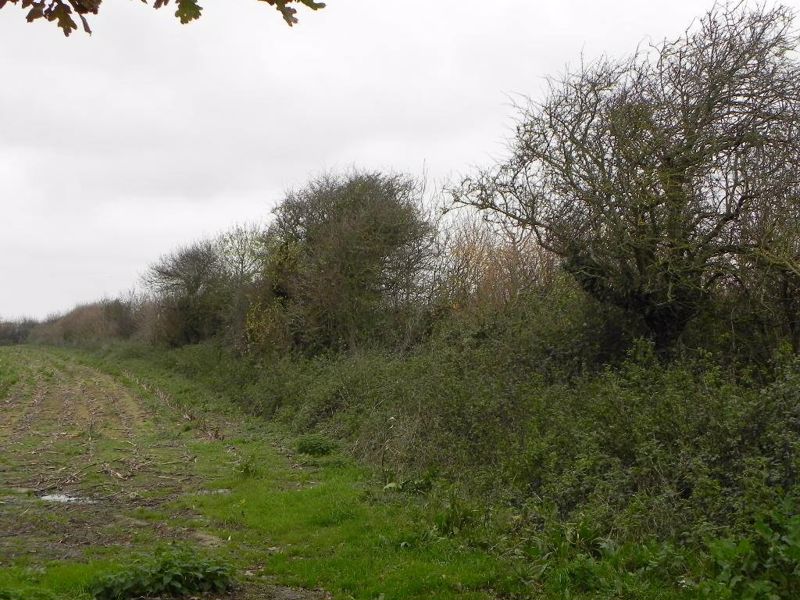 French hedgerows could be one hundred years old and were used by French farmers as natural fencing for the land. (author photo)
French hedgerows could be one hundred years old and were used by French farmers as natural fencing for the land. (author photo)One sergeant from Kansas decided to try to tackle this. Master Sergeant Dudley P. May, grew up on a farm north of Topeka. His parents would later tell the Topeka Daily Capital Dudley was a natural tinkerer and “could do almost anything with except make them talk.”
May used salvaged parts from German anti-tank and anti-glider barriers to design a system of blades that could be affixed to the front of the Allied tanks. According to General Dwight D. Eisenhower by the end of July 1944, “50 percent of all our tanks in that sector were equipped with the hedge cutters – we called them rhinoceroses.”
While the invention of these tank hedge cutters is largely credited solely to Sgt. Curtis G. Cullen, it is evident Sgt. Dudley May had a significant role in this project as well. When he was awarded the Bronze Star in January 1945, the citation stated it was for meritorious service in connection with military operations, in particular the design of “a satisfactory hedge cutter modification for tanks against the enemy.”
William "Bill" Esser (1920-2010)
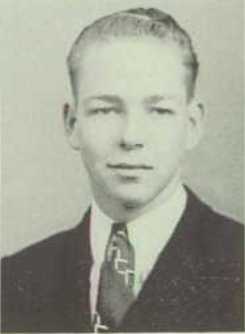 William Esser graduated from Topeka Catholic High School in 1939 and joined the Army in 1942. (TSCPL
William Esser graduated from Topeka Catholic High School in 1939 and joined the Army in 1942. (TSCPLBesides the hedgerows, another hazard the Allied forces had to contend with was land mines. German forces had set up several mine fields inland from the Normandy coast in anticipation of an Allied invasion. William “Bill” Esser was one of the lucky men who discovered a mine field but lived to tell about it.
Esser was born in Boonville, Missouri, on Jan 30, 1920, and the family relocated to Topeka soon after. He graduated from Topeka Catholic High School in 1939 and was inducted into the Army in 1942 where he served as a combat engineer attached to the 1st U.S. Army.
Once he landed in France Esser and his fellow engineers were tasked with purifying water in streams to be used for drinking water, in kitchens and in hospitals. Before working on a particular stream, the engineers first had to walk upstream a ways to make sure the water wasn’t polluted by the bodies of fallen soldiers or the corpses of livestock killed during the fighting.
On July 27, 1944, during a foray to ascertain the condition of a stream, Esser stepped into a German mine field and right on a landmine. The resulting explosion blew him into the air, shredded the lower half of his right leg and sprayed his left leg with shrapnel. Esser later recalled that, while his right leg had “no meat on the bone,” it hurt less than his less-damaged left leg.
Esser spent the next year in various hospitals in the UK and America. His right leg was amputated below the knee, and he was also left with poor circulation in his left leg and no hearing in his right ear. Esser was still having shrapnel removed from his right knee as late as 1990.
After being discharged from the service, Esser returned to Topeka where he went into business as a flooring contractor. He owned and operated Esser and Son Hardwood Floor Co. for nearly 55 years. He died on July 4, 2010, and was buried with military honors at Mount Calvary Cemetery in Topeka.
Sherman L. Oyler, Jr. (1920 - 1999)
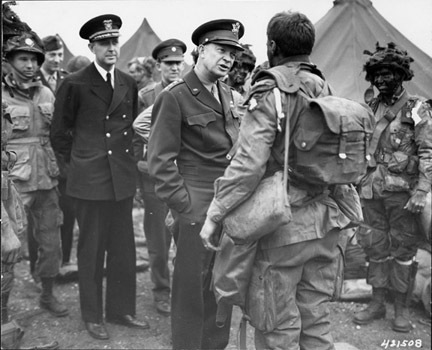 Sherman Oyler spoke with Gen. Eisenhower before his regiment took off for France. Oyler can be seen in this photograph standing at the far left. (Photo courtesy of the Eisenhower Presidential Museum)
Sherman Oyler spoke with Gen. Eisenhower before his regiment took off for France. Oyler can be seen in this photograph standing at the far left. (Photo courtesy of the Eisenhower Presidential Museum)One Kansas soldier had two brushes with celebrity while he was overseas. Sherman J. Oyler, Jr. was born in Caldwell, Kansas, on Dec 30, 1920, and was inducted into the Army shortly after graduating from Wellington High School. He served as a staff sergeant in the 2nd Battalion, 502nd Parachute Infantry Regiment of the 101st Airborne.
On July 5, 1944, while waiting for the orders to take off, Oyler’s regiment received a visit from General Dwight D. Eisenhower. As Eisenhower approached the troops, he asked if any of the men there were from Kansas and Oyler’s friends pushed him to the front of the crowd. Initially he was tongue-tied in front of Eisenhower, who Oyler considered a personal hero, but he managed to give the general his name and where he was from. Eisenhower replied, “Go get ‘em, Kansas.” Oyler can even be seen in the famous photographs of Eisenhower meeting with the troops before the invasion.
After parachuting into France on D-Day, Oyler also participated in Operation Market Garden later in the month. When he landed in Holland, Oyler found himself having to avoid enemy mortar fire. He leapt into a nearby ditch and landed right on top of Walter Cronkite, who was a war correspondent at the time. Oyler later recalled that Cronkite “said some things you couldn’t air on television.”
After the war Oyler returned to Kansas, where he earned a bachelor’s and master’s degree in education at Kansas State Teachers College in Emporia. He became a beloved history teacher at Highland Park High School, Highland Park Junior High and Jardine Middle School. When he taught the history of World War II, Oyler would give a presentation to his students where he would wear his old jump uniform and demonstrate proper parachuting techniques by jumping off a desk. Oyler said he wanted to give his students an idea of what it was really like; “I tell them what personally happened to me . . . what I saw, what I experienced and what I smelled.”
Sherman J. Oyler, Jr. died in 1999 at the age of 78 and was buried with military honors at Mount Hope Cemetery.
The Men Who Helped Free a Continent
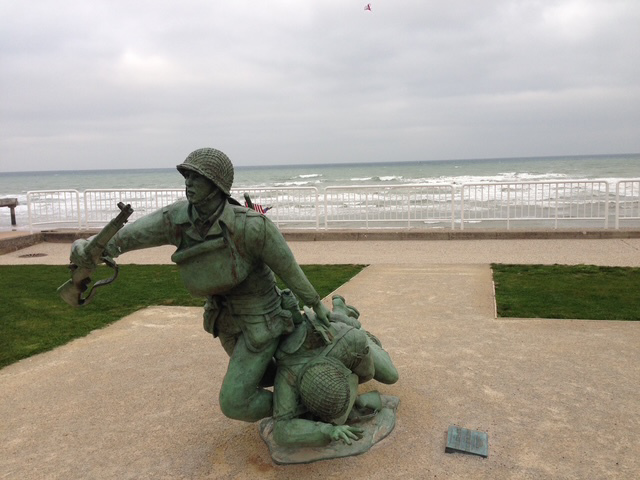 "Ever Forward", a monument to the 116th Infantry Regimental Combat Team on Omaha Beach, Normandy, France (author photo).
"Ever Forward", a monument to the 116th Infantry Regimental Combat Team on Omaha Beach, Normandy, France (author photo).Today there are only a handful of men left alive who participated in the Normandy invasion. While most may be gone, their stories of bravery, courage and determination live on. To learn more about the lives of the men mentioned here, as well as others who served during World War II, visit the library’s Topeka Room. To hear more about the story of one particular Kansas soldier, please join the library on Fri, Sept 5, 5:30pm as we host Chad Neighbor who will tell about his father’s experiences during the Normandy invasion in One Man's War Story.


